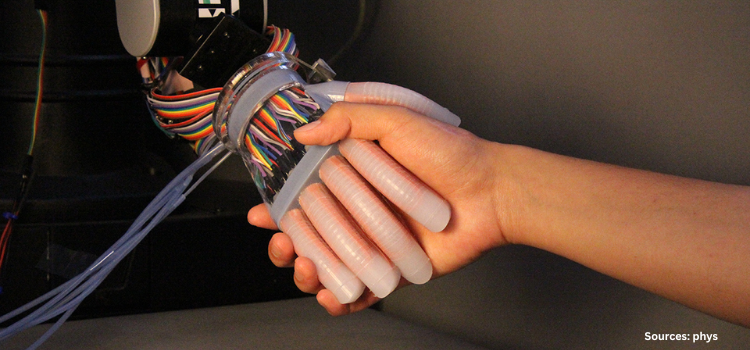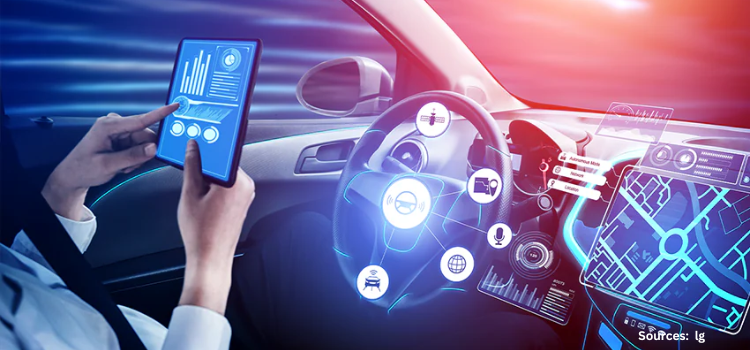AI-Powered Tactile Sensors Revolutionizing Industry with Touch
17-Feb-2025

Introduction
In the landscape of industrial technology, the integration of artificial intelligence (AI) with tactile sensors is emerging as a game-changer. These sensors, which mimic the human sense of touch, are transforming daily operations by implementing automation, improving efficiency, and enabling new capabilities in robotics and manufacturing. This article explores the impact of AI-powered tactile sensors, highlighting their benefits, applications, and future potential.
Understanding Tactile Sensors
Tactile sensors are devices designed to detect and measure touch, pressure, and texture. Unlike traditional sensors that primarily gather visual or auditory data, tactile sensors provide detailed information about physical interactions. They can measure parameters such as force, temperature, and vibration. This way, they offer a rich dataset that can be analyzed to make more informed decisions.
When combined with AI, tactile sensors become even more powerful than before. AI algorithms can process the complex data from these sensors in real time. It enables machines to "feel" and respond to their environment with human-like sensitivity and precision. This integration is paving the way for smarter, and adaptive industrial systems.
The Role of AI in Tactile Sensing
AI enhances the functionality of tactile sensors in several ways. Machine learning algorithms can be trained to recognize patterns and anomalies in tactile data, allowing systems to predict and respond to various conditions. For instance, AI can help a robotic hand adjust its grip to handle fragile objects without breaking them or apply the right amount of pressure needed for different tasks. Moreover, AI-powered tactile sensors can continuously learn and improve from new data. They will lead to more accurate and reliable performance over time. This self-learning capability is particularly valuable in dynamic industrial environments in which conditions can change rapidly. A research team from the National University of Singapore (NUS) developed an open-source tactile sensor named the Asynchronous Coded Electronic Skin (ACES). This innovation aimed to enhance the tactile sensing capabilities of AI systems, providing more nuanced and precise touch data than before. ACES contributed to the development of more responsive and intelligent AI applications in robotics and prosthetics. It enabled the detection of various tactile stimuli such as texture, shape, and softness. This development significantly impacted the AI tactile sensors market by introducing advanced, cost-effective, and accessible technology, fostering further innovation and adoption.
Benefits for Industry
Enhanced Precision and Control
One of the primary benefits of AI-powered tactile sensors is the enhanced precision and control they bring to industrial processes. In manufacturing, for example, these sensors can detect minute variations in surface textures and apply the exact amount of force needed for assembly tasks. This, in turn, reduces the risk of damage and improves the product quality.
Improved Safety
AI-powered tactile sensors contribute significantly to improving safety in industrial settings. Robots equipped with these sensors can detect human presence and adjust their movements to avoid collisions. This significantly reduces the risk of workplace accidents. Additionally, they can monitor the condition of machinery and alert operators to potential issues before they lead to failures.
Increased Efficiency
Efficiency is a critical factor in industrial operations, and AI-powered tactile sensors can enhance it in multiple ways. By providing real-time feedback and enabling adaptive control, these sensors help optimize production processes, reduce downtime, and increase throughput. They also facilitate predictive maintenance, allowing companies to address equipment issues proactively rather than reactively.
Versatility
The versatility of AI-powered tactile sensors makes them suitable for a wide range of applications across different industries. From automotive and aerospace to electronics and healthcare, these sensors can be integrated into various systems to enhance performance and innovation. Their ability to adapt to different tasks and environments adds significant value to industrial operations.
The versatility of AI-powered tactile sensors makes them a game-changer across a wide range of industries. From the intricate world of electronics manufacturing to the delicate operations within healthcare, these sensors seamlessly integrate into various systems. They also boost performance and drive innovation. Their adaptability to diverse tasks and environments brings significant value to industrial operations.
Applications:
In manufacturing, these sensors are revolutionizing quality control and assembly processes. Imagine production lines for electronic devices. Here, AI-powered tactile sensors can detect defects in microchips or other components that are minuscule and invisible to the human eye. Furthermore, they can be deployed in automated assembly lines to ensure parts are fitted together with the correct pressure and alignment. This, in turn, leads to increased product reliability and lifespan.
Robotics is another field experiencing a significant transformation thanks to AI-powered tactile sensors. In industrial settings, these sensors empower robots to undertake delicate tasks requiring a high degree of dexterity. For instance, robots can now handle fragile materials or perform intricate assembly operations with a newfound precision. When it comes to service robotics, tactile sensors enable robots to interact with humans in more natural and safer manner. This enhances their usability in healthcare, hospitality, and domestic applications. Furthermore, they pave the way for a future where robots seamlessly integrate into our daily lives.
The healthcare industry is also embracing AI-powered tactile sensors to develop advanced prosthetics and surgical robots. Prosthetic limbs equipped with these sensors can provide users with a sense of touch, a crucial element for interacting with their environment and performing everyday tasks. Imagine the life-changing impact this can have on individuals who have lost limbs. Surgical robots, on the other hand, benefit from enhanced precision and control. This allows surgeons to perform complex procedures with greater accuracy and lower risk of complications. This significantly leads to improved patient outcomes.
The automotive industry is leveraging AI-powered tactile sensors to elevate the safety and performance of vehicles. These sensors can be integrated into car seats to monitor the driver's posture and adjust seating positions for optimal comfort & safety. Additionally, they can be incorporated into autonomous vehicles to enhance the perception of their surroundings. This enables accurate and responsive navigation, paving the way for a future of safer and more reliable self-driving cars. The applications of AI-powered tactile sensors are vast and constantly evolving. As this technology continues to develop, we can expect even more transformative advancements across a multitude of industries.
The Future of AI-Powered Tactile Sensors
The future of AI-powered tactile sensors looks promising, with ongoing advancements in AI and sensor technology driving their evolution. Here are some key trends and developments to watch for:
1. Miniaturization
As sensor technology continues to advance, we can expect to see smaller and more compact tactile sensors that can be integrated into a wider range of devices and applications. This miniaturization will open up new possibilities for innovation, particularly in wearable technology and portable devices.
2. Enhanced AI Algorithms
The development of more sophisticated AI algorithms will enhance the capabilities of tactile sensors, enabling them to process and interpret data with accuracy and speed. These improvements will further improve the precision, efficiency, and adaptability of industrial systems.
3. Broader Adoption
As the benefits of AI-powered tactile sensors become more widely recognized than before, their adoption is likely to increase across various industries. This will drive further innovation and investments in the technology, leading to new applications and use cases.
4. Collaboration and Ecosystem Development
Collaboration between industry leaders, technology providers, and research institutions will be crucial to advancing the development and deployment of AI-powered tactile sensors. Building a robust ecosystem that supports innovation, standardization, and best practices will help accelerate the adoption of these sensors and maximize their impact on various industries.
Conclusion
AI-powered tactile sensors represent a significant advancement in industrial technology, offering numerous benefits in terms of precision, safety, efficiency, and versatility. By enabling machines to "feel" and respond to their environment, these sensors are transforming industries and driving innovation in manufacturing, robotics, healthcare, and automotive applications.
While there are challenges to overcome, the potential of AI-powered tactile sensors to revolutionize industrial processes and enhance sustainability is undeniable. Industry leaders must prioritize investments in this technology, foster collaboration, and address integration and standardization issues to fully realize its benefits.
As we move towards a future where AI and tactile sensing become integral components of industrial systems, the opportunities for improved performance, innovation, and competitiveness are immense. Embracing AI-powered tactile sensors will not only enhance operational efficiency but also contribute to a smarter, more adaptive, and sustainable industrial landscape.
About the Author
 Saurav Sarkar is an accomplished researcher and writer with over three years of experience in conducting thorough research. His passion for exploring various subjects and delving into in-depth analysis has led him to develop a keen understanding of research nuances. He remains committed to staying current with the latest market trends, recognizing their impact on businesses and society. The author can be reached at saurav.sarkar@nextmsc.com
Saurav Sarkar is an accomplished researcher and writer with over three years of experience in conducting thorough research. His passion for exploring various subjects and delving into in-depth analysis has led him to develop a keen understanding of research nuances. He remains committed to staying current with the latest market trends, recognizing their impact on businesses and society. The author can be reached at saurav.sarkar@nextmsc.com
Add Comment
Related Blogs
How Technological Advancements in Digital Pen is Reshaping the Market
Introduction As the digital pen market continues to evolv...
Smart Dust: The Future of Sensor Technology
Introduction Smart Dust is a collection of several microelectromechanical systems (MEMS) such as sensors and other devices that...
Top 5 Trends in Semiconductor Industry
The global semiconductor industry has been evolving and growing steadily. This growth has largely been driven by the soaring deman...










